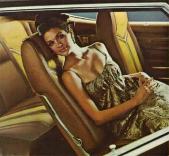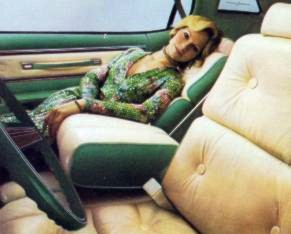1964-1979 Ford Thunderbird
|
|
Often Ordered During Some Years, But Rarely Seen In Others |
|
|
Thunderbird's list of options grew longer for 1964 as well. Speed Control appeared for the first time. It was actually planned for 1963 but was delayed due to problems. The Safety-Convenience Control Panel flashed lights to remind of a door ajar or low fuel. A flick of a switch activated exterior flashers to warn oncoming cars, and another locked or unlocked both doors. But one of the most appreciated new options was the Reclining Passenger Seat. Especially nice on long trips, it allowed the passenger to recline the seat back to an almost horizontal position. The top section of the seat back served as a built-in headrest, that could be raised about 10 inches to serve as a pillow while the seat back was in the reclined or upright position. Front seat passengers could even take a nap on long trips. A lever, mounted on the outboard side of the seat, when lifted allowed the seat back to recline with minimal pressure. Once the lever was released, the seat back locked in place, but could be pushed or pulled up to the normal upright position if desired. Internal springs raised the seat back when the lever was raised, if the passenger sat upright. The reclining seat was available as a separate option on all models, and with all interior trim combinations. And it proved to be a popular option, as it turned up on quite a few cars during the 1964-1966 era. It was combined with the leather interior trim option in 1966, which made it a mandatory option when leather was specified. However, it was still available separately with the all-vinyl and cloth and vinyl interiors. Then in 1967, Ford did something strange. They took this popular option and made it a rare one. It was no longer available with all interior trim colors. Standard vinyl interiors had to be one of only two colors—black or parchment—to be eligible to order the reclining seat. It was still available with the extra cost SL interiors, an upgraded cloth and vinyl or leather option. Why Ford did this is peculiar. Perhaps it was to encourage people to order the interior upgrade. To operate the 1967 seat, a button on the seat cushion side shield could be pressed, which activated a solenoid in the seat back that release a latch and allowed the back to recline. When the button was released, the solenoid locked the seat back in place. Forward pressure would still move the seat back to the upright position, and another touch of the button would allow internal springs to do so as well. At any rate, few people ordered the reclining seat in 1967, even if they did pop the extra cash for the SL interior. This trend continued in 1968. Now available with all trim materials and colors, it no longer came with a built-in head rest. That meant buyers had to pay an extra $42.75 for the separate color-keyed head rest option. Without it, there was no support for their head when in the reclined position. The sales brochure for 1968 even shows the reclining seat option with no head rest. It didn't look comfortable, although the lovely model was smiling while she held her head up while lying down. Not very comfortable, and you certainly couldn't be expected to remain in that position for long. What in the world was Ford thinking? The situation didn't improve much for early 1969 Thunderbird models, either. Head rests remained optional on cars built prior to January 1, 1969, but became standard after that due to new Motor Vehicle Safety Standards that were enacted. Ford did drop the price to just $17 for the early cars, which certainly made them much more affordable than they had been, but few spent the extra money for the reclining seat.
At this time, it was still a bit unusual to find this option on other cars. Even luxury leader Cadillac was more interested in promoting their "Dual Comfort" front seat, also known as the "60/40" seat, in which the front seat was divided, with the driver's portion consisting of 40% of the width, and the wider passenger side receiving 60% of the width. The center fold-down arm rest was mounted on the passenger's side. Normally, both sides were power operated and the Dual Comfort seat was optional on most models, but there is no mention of a reclining feature in either the 1972 Cadillac sales brochure, nor in the Owner's Manual for that year. We know a reclining seat had been offered by Cadillac in the mid-sixties as an option on the Fleetwood Eldorado Convertible, but it was apparently discontinued at some point. General Motors' Buick Riviera also offered a reclining seat option in the mid-sixties, but relatively few were ordered.
As the Thunderbird down sized both its physical dimensions and price for 1977, it became less of a luxury car and more of an affordable mid-size with personal touches to set it apart. Yet it still carried that magical name, which helped the 1977-1979 cars sell in numbers that were almost unbelievable for a true personal luxury car. To date, this period still stands as the one with best sales. The cars of this period that were ordered with few options, more what you would expect on a Torino or Galaxie 500, normally do not have the reclining seat, while cars with lots of options were more likely to also have the reclining seat. It's a mystery why Ford planners made the decision to restrict this option to specific interior colors and trims for 1967, but there's no doubt that had an impact on the popularity of this feature, since installations plummeted after 1967, even though the price remained fairly consistent. No doubt this move was a cost cutting measure on Ford's part, or an attempt to up the total customers spent on options, but whatever it was they would have been well advised to leave well enough alone. This was a comfort feature that made the Bird stand out, as it either wasn't available on the competition, or wasn't promoted much which resulted in few Rivieras, Toronados, and Eldorados being ordered so equipped. This is just one more reason why Thunderbird was unique in all the world. |
|
 With all-new styling inside and out, the 1964 Thunderbird was a show stopper.
But its beauty went much further than just physical appearance, Ford made
real, functional, improvements to the car that benefited the owners. For
instance, true instruments for oil pressure, fuel level, engine temperature,
and an ammeter gauge. The console glove compartment was bigger. Door and
quarter panel arm rests were more softly padded. Turn indicators atop the
front fenders reminded drivers that their turn signal was on. Silent-Flo
ventilation changed interior air several times a minute with the windows
up. All of these things made the Thunderbird a pleasure to drive, and allowed
driver and passengers to arrive at their destination more relaxed and refreshed.
With all-new styling inside and out, the 1964 Thunderbird was a show stopper.
But its beauty went much further than just physical appearance, Ford made
real, functional, improvements to the car that benefited the owners. For
instance, true instruments for oil pressure, fuel level, engine temperature,
and an ammeter gauge. The console glove compartment was bigger. Door and
quarter panel arm rests were more softly padded. Turn indicators atop the
front fenders reminded drivers that their turn signal was on. Silent-Flo
ventilation changed interior air several times a minute with the windows
up. All of these things made the Thunderbird a pleasure to drive, and allowed
driver and passengers to arrive at their destination more relaxed and refreshed. For 1970-1971, it was slightly more popular, and it even became a part
of the Turnpike Convenience Group for 1971, but the majority of cars built
still were not equipped with this once popular option. Operation returned
to a manually-controlled lever on the seat cushion side shield, doing away
with the electric solenoid. The recliner was available with bench and bucket
seat installations, and in all trim colors and materials.
For 1970-1971, it was slightly more popular, and it even became a part
of the Turnpike Convenience Group for 1971, but the majority of cars built
still were not equipped with this once popular option. Operation returned
to a manually-controlled lever on the seat cushion side shield, doing away
with the electric solenoid. The recliner was available with bench and bucket
seat installations, and in all trim colors and materials. Installation percentages increased somewhat for 1972, as the T-bird shed
a bit of its sporty image and went for a full-out luxury car, and then
skyrocketed for 1973-1976, due simply to the fact that most Thunderbirds
were now loaded up with extra cost options, in keeping with the luxury
image, and the reclining seat was a part of the now very popular Turnpike
Convenience Group, which included speed control. By 1976, Cadillac was
offering a power recliner option for passenger seats, as well as a manual
recliner for the driver's side. The power recliner feature was standard
equipment on the Fleetwood Talisman.
Installation percentages increased somewhat for 1972, as the T-bird shed
a bit of its sporty image and went for a full-out luxury car, and then
skyrocketed for 1973-1976, due simply to the fact that most Thunderbirds
were now loaded up with extra cost options, in keeping with the luxury
image, and the reclining seat was a part of the now very popular Turnpike
Convenience Group, which included speed control. By 1976, Cadillac was
offering a power recliner option for passenger seats, as well as a manual
recliner for the driver's side. The power recliner feature was standard
equipment on the Fleetwood Talisman.